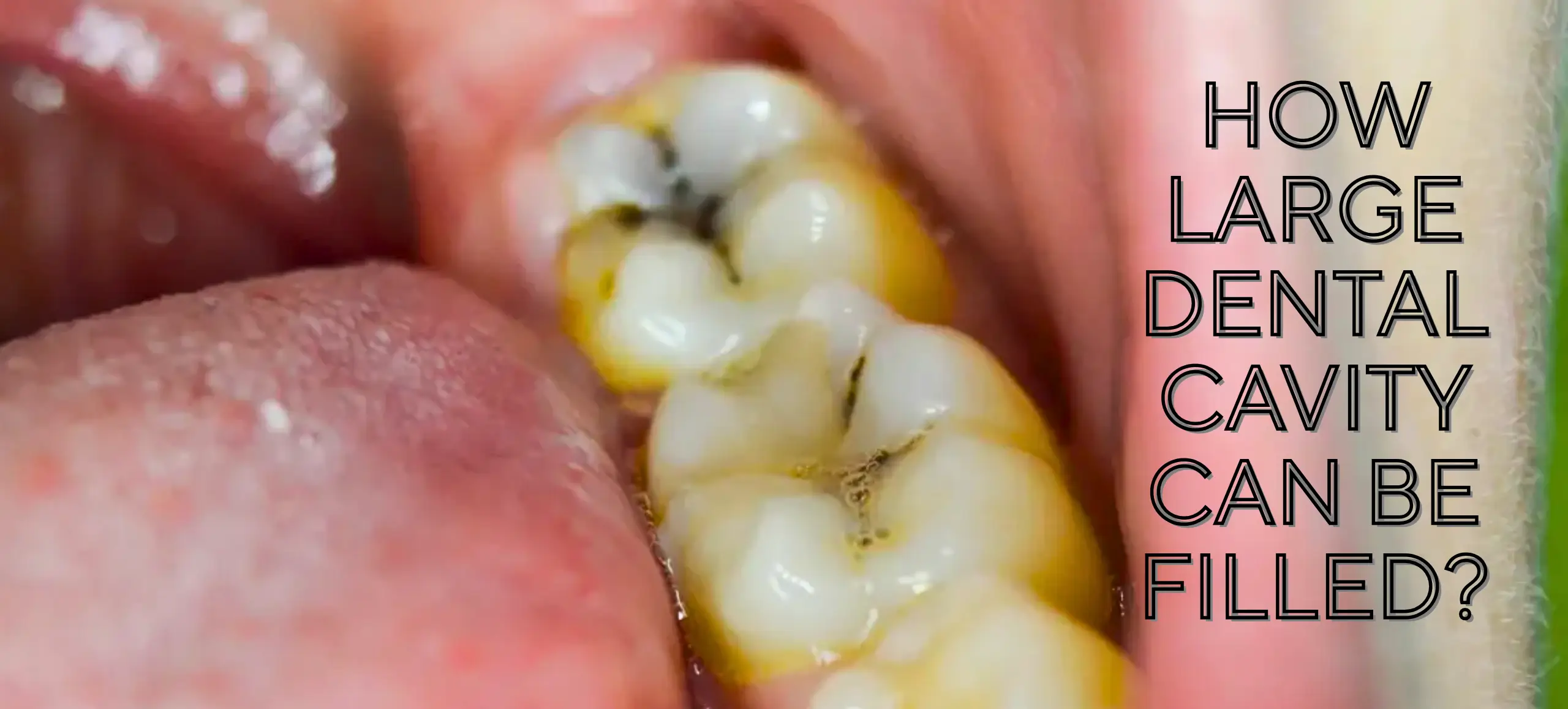A cavity is damaged tooth structure caused by decay. If left untreated, it grows deeper and wider. Sometimes, it forms a large hole in the tooth. At this stage, many people think the tooth cannot be saved. But that’s not always true.
Even large cavities can often be filled, if the decay hasn’t reached the nerve or weakened the tooth completely. The dentist checks how much healthy enamel and dentin remain. If enough structure is left, a filling can still work well.
The size and depth of the cavity decide the treatment. Small to moderate cavities are filled easily. Large cavities may need stronger materials or support from a crown. If the pulp is affected, a root canal might be needed before the filling.
In this blog, you’ll learn how large cavities are assessed, when a filling is possible, and what to expect after treatment. This will help you understand your options clearly, and act before the damage gets worse.
Cavity Filling Before and After

How Big Can A Cavity Be Filled
Most cavities, even large ones, can be filled. But it depends on how much of the tooth is still healthy.
A filling works when the tooth has enough structure left to support it. If the cavity has not reached the pulp, the soft tissue inside the tooth, a direct filling is often possible. Composite resin or amalgam is usually used for this.
But when the decay goes deeper, the tooth may need more than just a basic filling. If too much enamel or dentin is lost, the filling may not hold well. In these cases, your dentist will look for alternatives that offer better support.
For example:
- Inlays or onlays are used when the damage is too big for a filling but not large enough for a crown.
- Crowns are recommended when most of the tooth is gone, and full coverage is needed.
- If the decay reaches the pulp, a root canal is done first. Then the tooth is restored with a filling or crown.
Every case is different. That’s why a dentist examines the tooth carefully, using X-rays if needed, to decide the right treatment. The goal is always the same: to save the tooth and make it function like normal again.
Difference Between Root Canal and Cavity Filling
| Feature | Cavity Filling | Root Canal |
| Purpose | Fills decayed part | Treats infected pulp |
| Pain | Mild discomfort | Requires numbing |
| Cost | Affordable | Higher cost |
| Time | Single visit | May need multiple visits |
What to Expect After a Tooth Filling
After a filling, some changes in your mouth are normal. Here’s what most patients experience:
🔹 Mild sensitivity
- You may feel slight discomfort with hot, cold, or sweet food.
- This usually goes away in a few days.
- It’s more common if the cavity was deep.
🔹 Numbness for a few hours
- The anaesthetic can last 2 to 4 hours after the procedure.
- Avoid eating until the numbness wears off.
- This prevents accidental biting of your tongue or cheek.
🔹 Bite may feel “off”
- If the filling feels high or uneven, it can affect your bite.
- A quick adjustment by your dentist can fix it.
- Don’t wait, biting pressure on a high filling can damage the tooth.
🔹 Pressure or tightness in the tooth
- A filled tooth might feel slightly different at first.
- This is normal and settles within a few days.
🔹 Avoid hard or sticky food (first 24 hours)
- Especially important if the filling is large.
- It helps the material settle and protects the tooth.
🔹 Maintain good oral care
- Brush gently around the area.
- Rinse well.
- Report any sharp pain, swelling, or long-lasting sensitivity to your dentist.
✅ A good filling should feel natural. You should be able to eat and speak comfortably once your mouth adjusts.
Final Note
If you have a large cavity, don’t panic. In many cases, it can still be filled and saved.
What matters is how soon you get it treated. The earlier we catch it, the simpler the solution. A tooth filling is often enough, even for bigger cavities, if the damage hasn’t reached the nerve.
But if you wait too long, the tooth may need more complex work like a crown or root canal. That’s why it’s important not to ignore signs like a big hole in your tooth, pain, or food getting stuck.
The good news? Fillings today are strong, safe, and blend in naturally. Most people feel back to normal within a day or two.
If you’re unsure about your tooth, get it checked. A short dental visit could save you a lot of trouble later.
Your teeth do a lot for you. Let’s take care of them, before the damage goes too far.
FAQs About Tooth Fillings
Can you brush your teeth after a cavity filling?
Yes, you can. Just be gentle around the filled tooth. Use a soft-bristled brush and avoid putting too much pressure on that area, at least for the first 24 hours.
How many fillings can a dentist do at once?
Most dentists can safely do 2 to 4 fillings in one visit. It depends on how big the cavities are and where they’re located in your mouth. If you need more, the treatment may be split over two appointments for comfort.
Can you get a filling without numbing?
Yes, in some cases. If the cavity is very small and shallow, numbing might not be needed. But most dentists still recommend it, to make sure you don’t feel any pain or sensitivity during the procedure.
Can I get a cavity filled while pregnant?
Yes. Dental fillings are generally safe during pregnancy. The second trimester is usually the best time for treatment. Always inform your dentist if you’re pregnant, they’ll take extra care with timing and materials.
Can you drink after a cavity filling?
Yes, but wait until the numbness wears off. Avoid hot drinks during that time. Stick to soft, room-temperature fluids to stay safe and comfortable.
Can a cavity come back after filling?
It can. If you don’t clean the area well or if the filling gets worn or cracked over time, new decay can form around it. Regular dental check-ups help catch problems early.

